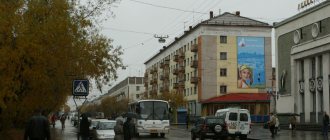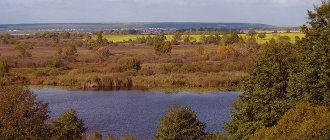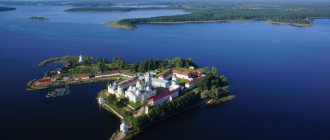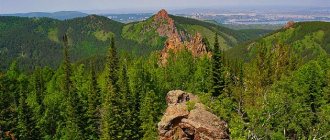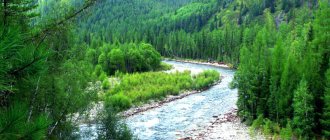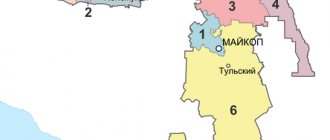Republic of Karelia on the map
Karelia is located in the north-west of Russia on the border with the Leningrad region and about half of its territory is covered with forests, and another quarter is covered with water (lakes and rivers). That is why Karelia is often called the land of lakes - there are more than fifty thousand of them, and almost thirty thousand rivers.
Karelia, a protected region of lakes and forests, is located in the north-west of Russia,
Karelia stretches for almost 700 kilometers from north to south (from the Kola Peninsula to the middle of Lake Ladoga) and more than 400 kilometers from east to west (between the Arkhangelsk region and Finland), so you can essentially travel through it in almost one day, but a lot depends on the condition of the roads at certain times of the year.
History of the republic's ATD
The Karelian labor commune was formed on June 8, 1920 from parts of the Olonetsky, Petrozavodsk, Povenets districts of the Olonets province and the Kem district of the Arkhangelsk province.
- September 18, 1922 - Povenets district and the city of Pudozh, Avdeevskaya, Vodlozerskaya, Kolovskaya, Korbozerskaya and Nigizhemskaya volosts of Pudozhskaya district from the Olonets province were transferred to the Karelian Labor Committee.
- 1923 - The Karelian Labor Commune was transformed into the Autonomous Karelian SSR (AKSSR) consisting of 7 counties: Kemsky, Olonetsky, Petrozavodsk, Povenetsk, Pudozhsky, Ukhtinsky and Padansky.
- On November 3, 1924, part of the territory of the Lodeynopolsky district of the Leningrad province was transferred to Karelia.
Administrative division of the Autonomous Karelian SSR on January 1, 1926: [7]:
| County | parishes |
| Kemsky district | Vychetaybolskaya, Kandalaksha, Keretskaya, Knyazhegubskaya, Kovdskaya, Kolezhemskaya, Laninskaya, Nadvoitskaya, Letnekonetskaya, Maslozerskaya, Nyukhotskaya, Pogostskaya, Poduzhenskaya, Pongamskaya, Sorokskaya, Sumsko-Posadskaya, Tungudskaya, Shueretskaya |
| Olonetsky district | Vedlozerskaya, Vidlitskaya, Kotkozerskaya, Loyanskaya, Pekkulskaya, Rypushkalskaya, Tulomozerskaya |
| Padansky district | Padanskaya, Poros-Ozerskaya, Rebolskaya, Rugozerskaya, Kimas-Ozerskaya |
| Petrozavodsk district | Derevyanskaya, Kondopoga, Konchezerskaya, Kyanpeselga, Ladvinskaya, Myanduselga, Petrovskaya, Svyatozerskaya, Syamozerskaya, Tivdiyskaya, Sheltozersko-Berezhnaya, Shuyskaya, Yalgubskaya |
| Povenets district | Velikogubskaya, Danilovskaya, Kizhiskaya, Petrovsko-Yamskaya, Rimskaya, Tipinitskaya, Shungskaya, Lumbushsky district village council |
| Pudozhsky district | Avdeevskaya, Vodlozerskaya, Kolovskaya, Korbozerskaya, Nigizhemskaya |
| Ukhtinsky district | Voknavolotskaya, Kestengskaya, Kondokskaya, Olangskaya, Tikhtozerskaya, Ukhtinskaya, Yushkozerskaya |
- 1927 - Instead of counties, 26 districts were formed: Velikogubsky, Vidlitsky, Kandalaksha, Kemiretsky, Kemsky, Kestenga, Kondopoga, Loukhsky, Medvezhyegorsky, Olonetsky, Petrovsky, Povenetsky, Prionezhsky, Pudozhsky, Rebolsky, Rugozersky, Svyatozersky, Segezhsky, Segozersky, Soroka, Syamozersky , Tungudsky, Ukhtinsky, Shalsky, Sheltozero (national Vepsian), Shungsky.
- 1930 - As a result of administrative reform, the number of districts was reduced to 19: Zaonezhsky, Kandalaksha, Kemsky, Kestenga, Kondopoga, Loukhsky, Medvezhyegorsky, Olonetsky, Petrovsky, Petrozavodsky, Pryazhinsky, Pudozhsky, Rebolsky, Rugozersky, Segozersky, Soroka, Tungudsky, Sheltozersky, Ukhtinsky.
- On September 23, 1930, the Solovetsky Islands became part of the Kemsky region of the Autonomous Soviet Socialist Republic.
- On October 20, 1930, the Solovetsky Islands were withdrawn from the AKSSR and included in the Northern Territory
- 1935 - Vedlozersky district was formed. Ukhta district was renamed Kalevalsky.
- 1936 - Transformation of the Autonomous Karelian SSR (AKSSR) into the Karelian ASSR (KASSR).
- 1938 - Kandalaksha district was transferred to the Murmansk region. Soroka district was renamed Belomorsky.
- 1940 - The Karelian ASSR was transformed into the Karelo-Finnish SSR (KFSSR). It includes the Vyborg, Kexgolm, Kurkijoki, Pitkäranta, Sortavala, Suojärvi and Yaskinsky districts, which separated from Finland.
- 1944 - Vyborg, Kexholm and Yaskinsky districts were transferred to the Leningrad region.
- 1945 - Segezha district was formed
- 1948 — Rebolsky district was abolished
- 1952 - Karelia is divided into 2 districts - Petrozavodsk and Segezha.
- 1953 - Districts abolished.
- 1955-1956 - The Karelo-Finnish SSR was transformed into the Karelian Autonomous Soviet Socialist Republic (KASSR). The Kestengsky, Tungudsky, Vedlozersky, Segozersky, Sheltozero districts were abolished.
- 1957 - Pitkyaranta and Petrovsky districts were abolished.
- 1958 - Kurkiyoksky and Rugozersky districts were abolished.
- 1959 - Zaonezhsky district was abolished.
- 1966 - Muezersky and Pitkyaranta districts were formed.
- 1970 - Lakhdenpokhsky district was formed.
- 1991 - The Karelian Autonomous Soviet Socialist Republic was transformed into the Republic of Karelia.
- 1994 - The Vepsian national volost was formed as a district.
- 2005 - Vepsian national volost was abolished.
Map with roads
As for the road from Moscow/St. Petersburg to Karelia, it pleasantly surprised us! Smooth, high quality, and even with a bump stop (from oncoming cars). Therefore, we “flew” to nearby Karelia quite quickly. We drove around Lake Ladoga on the left, along the A121 Sortavala highway.
Map of the A121 St. Petersburg-Sortavala highway (red)
The P-21 "Kola" highway, which runs from St. Petersburg to Petrozavodsk (on the right side of Lake Ladoga to Lake Onega) is also maintained in fairly good condition, but sometimes there are repairs, which can cause you to lose time.
Highway R-21 Kola goes from St. Petersburg through the whole of Karelia
Driving around Karelia is very pleasant and easy. Many roads go through lakes, pine forests, beautiful rivers and rocky ridges.
However, the further you go, the worse the roads become. And in general, if you move a little to the side, you can expect anything. To some areas the roads are unpaved, there may be dead roads, or even severe off-road conditions.
Detailed map of the Republic of Karelia with roads (photo map-road.ru)
It is best to find out about the quality of each road you are going to drive on. When planning your route, be sure to take into account the effect of precipitation on cross-country ability. Also, fill the tank full, especially if you are heading into the middle of nowhere (for example, to Vottovaara, north-east of Lake Onega or north-west of Karelia).
Read more about roads and routes in Karelia in general in our article on how we drove around Karelia by car.
Karelia
The natural features of Karelia provide ample opportunities for active recreation. In addition, in this region they try to preserve the national traditions of indigenous peoples; you can get acquainted with them at festivals held in the republic.
Event tourism
Snow sculptures at the Hyperborea festival
© Petrozavodsk City District Administration Group on VKontakte
, the international winter festival “Hyperborea” is traditionally held in Petrozavodsk . He reveals the advantages of life in the north, in its specific climate, the severity of which does not interfere with enjoying life. One of the most spectacular events of the festival is the competition of snow and ice sculptures, which delight residents and guests of the city even after the holiday until spring.
A colorful costume procession, a kind of winter carnival, a snowman-making competition, winter swimming races, and an ice fishing championship with jigs are also organized. Participants of the event can ride a dog sled, treat themselves to hot fish soup, and the festival ends with a laser show and fireworks.
In May, an unusual event is held in Olonets - the traditional holiday “Olonia - the goose capital” . It is connected with the fact that in the spring the fields in the city area are chosen as a resting place by migratory wild geese, and huge flocks circle over the city itself.
The central event of the holiday is the goose race, in which domestic geese take part. This unpredictable and quite cheerful spectacle lifts the spirits of everyone present. In addition, water competitions on the Olonka River, concerts and an agricultural fair are held.
Republic Day is celebrated on June 8. Its peculiarity is that every year festive events are held in different districts. Due to climatic and other conditions, the date is sometimes postponed. In 2022, for example, the main events took place in Medvezhyegorsk, and the centenary of the formation of the republic in 2022 will be celebrated on a large scale in Petrozavodsk.
Tourists interested in traditional Karelian cuisine should visit the annual Karelian Gate festival in the city of Sortavala in June. Here you can not only try this Karelian pie with classic filling, but also try original versions.
The chefs also prepare the largest wicket and compete in preparing Karelian pies in various categories. In addition to the tasting, guests of the event can take part in a tournament in the ancient Karelian game kyukkä, which is reminiscent of small towns. In addition, the program includes performances by folk music and dance groups of the republic.
You can cheer yourself up and get acquainted with village life at the June international festival of laughter “Kindasovo” . It is held in the village of Kindasovo, in the Pryazhinsky district. Why are the celebrations held in this particular place? The fact is that in folklore there are many tales and stories about the unlucky residents of this village, which served as the basis for organizing a holiday of humor and laughter. Its program includes jokes, anecdotes, performances by famous Russian and foreign comedians, performances by creative groups, practical jokes and competitions.
On the last Saturday of June you can attend the celebration of the Day of the City of Petrozavodsk . Its numerous venues host carnival processions, theatrical performances, concerts, and summing up the results of competitions. But, perhaps, one of the most striking events of this day can be called the traditional holiday “Illusions of the Old City” . It is held in a quarter with historical wooden buildings, where you can see people in costumes of the 20th century, scenes of city life of the late 19th - early 20th centuries, take pictures in historical costumes, learn city dances and take part in the fun of that time. Numerous shops sell hot pies and pancakes, and there are also handmade souvenir fairs. Guests of the holiday can come in costumes and take part in a competition for the best dress.
Music festival “Ruskeala Symphony”
© Band of the music festival “Ruskeala Symphony” on VKontakte
Music lovers may be interested in the Ruskeala Symphony music festival , held in August. The highlight of the festival is its location - performances by musicians from different countries are held in the Ruskeala mountain park, among man-made marble quarries. The event program includes not only classical music, but also modern compositions in classical arrangements, as well as performances by jazz groups.
On the second weekend of July, it is worth visiting the traditional Vepsian holiday “Tree of Life” , held in the village of Sheltozero. Its goal is to preserve the traditions and language of the Vepsians, an indigenous small people of Karelia. Participants of the event will be able to taste national cuisine, watch concerts of creative groups, theatrical performances and folk sports competitions. An exhibition-fair of arts and crafts and crafts is also being organized.
Do you know that Olonets has its own winter character, Pakkaine? According to the legend invented by local residents, this cheerful guy was not afraid of even the most severe frosts and was the ringleader at all holidays. He also loved to travel, in every city he admired his reflection in the mirror, and when he left, it came out of the mirror and continued to live in these places.
According to tradition, on December 1, on Pakkaine’s birthday, all the reflections come to Olonets to take part in the Olonets Santa Claus Games . Winter characters from different cities take part in a carnival procession, compete in traditional winter games, sing and dance, entertaining guests of the event. Guests of the event will be able to take part in winter games and fun, see a collection of New Year's decorations from different years, and learn about the traditions and rituals of the Karelians.
Fishing and hunting in Karelia
Freshly caught fish soup
© Elena Kuleshina
Many people love fishing, because it is both outdoor recreation and moderate physical activity. And the pleasure from the process and the treasured trophies is a separate issue. Karelia has many rivers and lakes containing a wide variety of fish. Pike, burbot, trout, whitefish, bream, peled, grayling, perch and other species are often caught here. Both summer and winter fishing are common.
Popular places include Lake Ladoga, Shotozero and Syamozero in the Pryazhinsky district, Pyalozero in the Kondopozhsky district, Nyuk in the Kalevalsky district. You can go to the reservoir as a wild person with a tent, or choose a more comfortable option with accommodation at a recreation center, where, for a fee, they will help with organizing fishing and provide you with the necessary equipment.
Another popular recreation option is hunting. Often in Karelia they hunt bears, moose, fur-bearing animals (for example, hares, martens, stoats), upland and waterfowl. The list of species permitted for hunting, terms and conditions of hunting should be clarified on the website of the Ministry of Natural Resources and Ecology of the Republic of Karelia.
Seasonal holidays
Each season offers travelers its own interesting recreational opportunities.
Rafting in Karelia
Rafting on the Pongoma River
© Elena Kuleshina
A large number of rivers attract rafting enthusiasts to Karelia; such a pastime allows them to actively relax and enjoy the natural beauties of the republic. In spring, deep and fast rivers are difficult to navigate, so this period is suitable for people with extensive experience and the necessary equipment.
In summer, many rivers become comfortable even for rafting with children. Shuya occupies a special place among the most popular rivers for active recreation. It has interesting rapids, fast and calm sections. Other popular Karelian rivers for rafting include the Uksa, Chirka-Kem, Okhta, and Tumcha.
If you have experience and the necessary equipment, you can organize rafting on your own; beginners can turn to tour operators who take care of all the worries about organizing your vacation and provide you with the necessary gear and equipment. There are both small weekend tours and long routes that are complemented by fishing.
Hiking in Karelia
If you love nature, want to enjoy it to the fullest, and are not afraid of the delights of a camping life with a minimum of amenities, then you should go on a walking tour. Moderate physical activity, wonderful places with almost untouched nature, food cooked over a fire - all this awaits you on the hike.
Most often, such tours are organized to the top of Mount Vottovaara, which is shrouded in mystical secrets. In these places, seids were discovered - clusters of boulders that the Sami worshiped. Another popular route passes through Paanajärvi National Park.
Winter activities
Dog sledding
© Nastenka Pavlik
In cold, snowy times, it’s worth visiting a husky nursery to interact with these smart animals and enjoy a fun sled ride. The most famous nurseries are located in the villages of Kudama, Matrosy, Chalna, Kalevala.
For lovers of active sports - skiing and snowboarding - there are several ski resorts. The Yalgora resort, not far from Petrozavodsk, on the shores of Lake Onega, is popular. The elevation difference on the routes is up to 100 meters. There are several trails of varying degrees of difficulty, a training slope, and comfortable places to stay. Also known are the Gorka ski complex in Petro in the vicinity of Sortavala and the ski slope in Medvezhyegorsk.
Winter outdoor recreation and extreme sports combine snowmobiling. Travel agencies offer a variety of routes that pass through beautiful places in the republic; they can be either short or lasting several days.
Map of Karelia with lakes
There are more than 60,000 lakes in Karelia. In terms of their number per 1000 sq. km, the republic ranks first in the world. The rivers and lakes of Karelia belong to the basins of the Baltic and White Seas. The height of the watershed is about 150 - 200 meters.
The largest number of them is concentrated in the northern part of the republic, in the White Sea basin. To the southeast and south the number of lakes gradually decreases. The fewest of them are located in the southwest and east of Lake Onega.
The most popular lakes of Karelia on the map
Karelian lakes vary in size: from small “lambushkas” to the largest in Europe: Lakes Onega and Lake Ladoga. Lakes with an area of up to 1000 square meters predominate. meters, but there are many larger ones. The total lake content of the republic is 11.4%, which is higher than, for example, in Finland or the neighboring Murmansk region.
Municipal districts
| Number on the card | Area | Population | Area (km²) | Population density (persons/km²) | Urban population | Rural population | Adm. center | Urban settlements | Number of cities and towns | Number of rural settlements |
| 1 | Belomorsky | 17 034[5] | 12.930 | 1,4 | 11.563 | 9.502 | Belomorsk | 1 | 4 | |
| 2 | Kalevala National | 7063[5] | 13.030 | 0,6 | 5.274 | 4.196 | Kalevala | 1 | 3 | |
| 3 | Kemsky | 15 753[5] | 7.950 | 2,1 | 13.118 | 5.486 | Kem | 1 | 3 | |
| 4 | Kondopoga | 37 958[5] | 5.940 | 6,7 | 33.309 | 8.518 | Kondopoga | 1 | 8 | |
| 5 | Lakhdenpokhsky | 13 455[5] | 2.180 | 6,4 | 8.124 | 7.149 | Lahdenpokhya | 1 | 4 | |
| 6 | Loukhsky | 12 056[5] | 22.710 | 0,6 | 10.823 | 5.923 | Louhi | Chupa, Pyaozersky | 3 | 3 |
| 7 | Medvezhyegorsky | 28 602[5] | 13.730 | 2,2 | 22.725 | 11.447 | Medvezhyegorsk | Pindushi, Povenets | 3 | 6 |
| 8 | Muezersky | 10 535[5] | 18.180 | 0,6 | 3.795 | 10.818 | Muezersky | 1 | 7 | |
| 9 | Olonets National | 21 071[5] | 3.920 | 5,7 | 9.201 | 15.761 | Olonets | 1 | 9 | |
| 10 | Pitkyaranta | 18 249[5] | 2.270 | 8,5 | 12.540 | 9.391 | Pitkäranta | 1 | 4 | |
| 11 | Prionezhsky | 21 829[5] | 4.600 | 4,7 | — | 23246 | Petrozavodsk | — | 13 | |
| 12 | Pryazhinsky National | 14 456[5] | 6.430 | 2,3 | 4.174 | 12.708 | Yarn | 1 | 6 | |
| 13 | Pudozhsky | 18 908[5] | 12.660 | 1,6 | 9.864 | 14.750 | Pudozh | 1 | 7 | |
| 14 | Segezhsky | 37 906[5] | 10.640 | 3,7 | 42.209 | 3.754 | Segezha | Nadvoitsy | 2 | 4 |
| 15 | Sortavala | 31 246[5] | 2.190 | 14,5 | 25.259 | 7.626 | Sortavala | Vyartsilya, Helyulya | 3 | 2 |
| 16 | Suoyarvsky | 16 594[5] | 13.580 | 1,3 | 10.776 | 10.341 | Suoyarvi | 1 | 4 |
Municipalities
Belomorsky district:
- Belomorskoe urban settlement
- Letnerechenskoe rural settlement
- Nyukhchinskoye rural settlement
- Sosnovets rural settlement
- Sumposad rural settlement
Kalevala national region:
- Kalevala urban settlement
- Borovskoe rural settlement
- Luusalma rural settlement
- Yushkozerskoye rural settlement
Kemsky district:
- Kem urban settlement
- Krivoporozhskoe rural settlement
- Kuzemskoe rural settlement
- Rabocheostrovskoe rural settlement
Kondopoga district:
- Kondopoga urban settlement
- Girvas rural settlement
- Kedrozerskoe rural settlement
- Konchezerskoe rural settlement
- Resort rural settlement
- Kyappeselga rural settlement
- Novinskoye rural settlement
- Petrovskoye rural settlement
- Yanishpolskoe rural settlement
Lakhdenpokh district:
- Lakhdenpokh urban settlement
- Kurkiyoki rural settlement
- Miinal rural settlement
- Khiitolskoye rural settlement
- Elisenvaara rural settlement
Loukhi district:
- Loukhskoe urban settlement
- Pyaozerskoe urban settlement
- Chupa urban settlement
- Ambarnsky rural settlement
- Kestenga rural settlement
- Malinovarakki rural settlement
- Plotinskoe rural settlement
Medvezhyegorsky district:
- Medvezhyegorsk urban settlement
- Pindush urban settlement
- Povenets urban settlement
- Velikogubskoe rural settlement
- Padanskoe rural settlement
- Tolvuiskoe rural settlement
- Chebinskoe rural settlement
- Chelmuzhskoe rural settlement
- Shunga rural settlement
Muezersky district:
- Muezerskoe urban settlement
- Volomskoe rural settlement
- Ledmozerskoe rural settlement
- Lenderskoe rural settlement
- Peningskoe rural settlement
- Rebolskoe rural settlement
- Rugozerskoye rural settlement
- Sukkozero rural settlement
Olonetsky national district:
- Olonets urban settlement
- Vidlitskoe rural settlement
- Ilyinskoe rural settlement
- Kover rural settlement
- Kotkozerskoe rural settlement
- Kuitezhskoe rural settlement
- Megreg rural settlement
- Mikhailovskoye rural settlement
- Tuksinsky rural settlement
Pitkyaranta district:
- Pitkyaranta urban settlement
- Impilakhtinskoe rural settlement
- Lyaskelskoye rural settlement
- Salminskoye rural settlement (Karelia)
- Kharlu rural settlement
Prionezhsky district:
- Ladva-Vetkinskoye rural settlement
- Ladvinskoe rural settlement
- Garrison rural settlement
- Wooden rural settlement
- Derevyankskoe rural settlement
- Zaozerskoe rural settlement
- Reclamation rural settlement
- Novovilgovskoe rural settlement
- Pai rural settlement
- Ryboretskoye Vepsian rural settlement
- Sheltozersk Vepsian rural settlement
- Shokshinskoye Vepsian rural settlement
- Shuya rural settlement
Pryazhinsky national district:
- Pryazhinskoye urban settlement
- Vedlozerskoye rural settlement
- Kroshnozerskoye rural settlement
- Matrosskoe rural settlement
- Svyatozerskoye rural settlement
- Chalny rural settlement
- Essoyl rural settlement
Pudozhsky district:
- Pudozh urban settlement
- Avdeevskoe rural settlement
- Krasnoborskoe rural settlement
- Krivetskoe rural settlement
- Kubovskoe rural settlement
- Kuganavolokskoe rural settlement
- Pyalma rural settlement
- Shalskoe rural settlement
Segezha district:
- Segezha urban settlement
- Nadvoitsky urban settlement
- Valdai rural settlement
- Idel rural settlement
- Popovporozhskoe rural settlement
- Chernoporozhye rural settlement
Sortavala district:
- Vyartsila urban settlement
- Sortavala urban settlement
- Khelul urban settlement
- Kaalam rural settlement
- Khaapalampinskoe rural settlement
Suoyarvi district:
- Suoyarvi urban settlement
- Veshkel rural settlement
- Loymolskoe rural settlement
- Naistenjärvi rural settlement
- Porosozerskoe rural settlement
Map of Karelia with Cities
There are thirteen cities and about 800 villages and towns in Karelia. The population of Karelia is about 600,000 people, with 80% of the region being urban residents. About 30% of them live in the capital of the republic - Petrozavodsk.
Large cities and tourist centers of Karelia also include Kostomuksha, Kondopoga, Olonets, and Sortavala. A well-known tourist route passes through some settlements of the republic, which connects Russia, Finland, Norway, Sweden - it is called the “Blue Road”.
Main cities of Karelia on the map (photo karelia-on-line.ru)
Administrative-territorial structure
According to the Constitution of the Republic of Karelia and the Law “On the administrative-territorial structure of the Republic of Karelia”, the subject of the Russian Federation includes the following administrative-territorial units:[1][2]
- 3 cities of republican significance (Petrozavodsk, Kostomuksha, Sortavala)
- 15 districts.
There are 818 settlements in the Republic of Karelia, including:
- 13 cities,
- 11 urban-type settlements,
- 794 - towns, villages and hamlets.
What are the prices for holidays in Karelia?
You can find out the current prices for holidays in Karelia on leading websites for selecting profitable tours, excursions and air tickets.
Choose a tour to Karelia →
Find an excursion to Karelia →
Search for flights to Karelia →
Hotel prices in Karelia →
Remember that you can buy a tour to Karelia cheaper on Travelata.ru - search for tours from hundreds of tour operators! Use our promotional codes AF2000turcalendar for additional. discount of 2000 rubles (tours from 100 tr), AF1500turcalendar 1500 rubles (from 80 tr) and AF1000turcalendar 1000 rubles (from 60 tr)!
Check out the best deals on Travelata tours:
Notes
- [docs.cntd.ru/document/919001576 Constitution of the Republic of Karelia]
- [docs.cntd.ru/document/919319309 Law “On the administrative-territorial structure of the Republic of Karelia”]
- [docs.cntd.ru/document/919318312 Law “On Municipal Districts in the Republic of Karelia”]
- [docs.cntd.ru/document/919318467 Law “On granting urban settlements the status of urban district”]
- ↑ 123456789101112131415161718
www.gks.ru/free_doc/doc_2016/bul_dr/mun_obr2016.rar Population of the Russian Federation by municipalities as of January 1, 2016 - [www.ticrk.ru/ru/regions/region_3661.html Kostomuksha urban district. The author of the text is A. A. Kuchko]
- Territorial and administrative division of the USSR on January 1, 1926. - Moscow: Publishing House of the Main Directorate of Communal Services of the NKVD, 1926. - 284 p.
Links
Portal about Karelia
- Karelia on Wikipedia pagesThe edges Altai • Transbaikal • Kamchatka • Krasnodar • Krasnoyarsk • Perm • Primorsky • Stavropol • Khabarovsk Regions Amur • Arkhangelsk • Astrakhan • Belgorod • Bryansk • Vladimir • Volgograd • Vologda • Voronezh • Ivanovo • Irkutsk • Kaliningrad • Kaluga • Kemerovo • Kirov • Kostroma • Kurgan • Kursk • Leningrad • Lipetsk • Magadan • Moscow • Murmansk • Nizhny Novgorod • Novgorod • Novosibirsk • Omsk • Orenburg • Oryol • Penza • Pskov • Rostov • Ryazan • Samara • Saratov • Sakhalin • Sverdlovsk • Smolensk • Tambov • Tver • Tomsk • Tula • Tyumen • Ulyanovsk • Chelyabinsk • Yaroslavl Federal cities Moscow • St. Petersburg • Sevastopol3 Autonomous region Jewish Autonomous okrugs Nenets1 • Khanty-Mansiysk - Yugra2 • Chukotka • Yamalo-Nenets2 1 Located on the territory of the Arkhangelsk region 2 Located on the territory of the Tyumen region 3 The Republic of Crimea and Sevastopol are located on territory whose annexation to Russia has not received international recognition
An excerpt characterizing the administrative-territorial division of the Republic of Karelia
“Let me through, I’m telling you,” Prince Andrei repeated again, pursing his lips. - And who are you? - the officer suddenly turned to him with drunken fury. - Who are you? You (he especially emphasized on you) are the boss, or what? I'm the boss here, not you. “You go back,” he repeated, “I’ll smash you into a piece of cake.” The officer apparently liked this expression. “He shaved the adjutant seriously,” a voice was heard from behind. Prince Andrei saw that the officer was in that drunken fit of causeless rage in which people do not remember what they say. He saw that his intercession for the doctor’s wife in the wagon was filled with what he feared most in the world, what is called ridicule [ridiculous], but his instinct said something else. Before the officer had time to finish his last words, Prince Andrei, with a face disfigured from rage, rode up to him and raised his whip: “Please let me in!” The officer waved his hand and hurriedly drove away. “It’s all from them, from the staff, it’s all a mess,” he grumbled. - Do as you please. Prince Andrei hastily, without raising his eyes, rode away from the doctor's wife, who called him a savior, and, recalling with disgust the smallest details of this humiliating scene, galloped further to the village where, as he was told, the commander-in-chief was located. Having entered the village, he got off his horse and went to the first house with the intention of resting at least for a minute, eating something and bringing into clarity all these offensive thoughts that tormented him. “This is a crowd of scoundrels, not an army,” he thought, approaching the window of the first house, when a familiar voice called him by name. He looked back. Nesvitsky’s handsome face poked out from a small window. Nesvitsky, chewing something with his juicy mouth and waving his arms, called him to him. - Bolkonsky, Bolkonsky! Don't you hear, or what? “Go quickly,” he shouted. Entering the house, Prince Andrei saw Nesvitsky and another adjutant eating something. They hastily turned to Bolkonsky asking if he knew anything new. On their faces, so familiar to him, Prince Andrei read an expression of anxiety and concern. This expression was especially noticeable on Nesvitsky’s always laughing face. -Where is the commander-in-chief? – asked Bolkonsky. “Here, in that house,” answered the adjutant. - Well, is it true that there is peace and surrender? – asked Nesvitsky. - I'm asking you. I don’t know anything except that I got to you by force. - What about us, brother? Horror! “I’m sorry, brother, they laughed at Mak, but it’s even worse for us,” Nesvitsky said. - Well, sit down and eat something. “Now, prince, you won’t find any carts or anything, and your Peter, God knows where,” said another adjutant. -Where is the main apartment? – We’ll spend the night in Tsnaim. “And I loaded everything I needed onto two horses,” said Nesvitsky, “and they made me excellent packs.” At least escape through the Bohemian mountains. It's bad, brother. Are you really unwell, why are you shuddering like that? - Nesvitsky asked, noticing how Prince Andrei twitched, as if from touching a Leyden jar. “Nothing,” answered Prince Andrei. At that moment he remembered his recent clash with the doctor’s wife and the Furshtat officer. -What is the commander-in-chief doing here? - he asked. “I don’t understand anything,” said Nesvitsky. “All I understand is that everything is disgusting, disgusting and disgusting,” said Prince Andrei and went to the house where the commander-in-chief stood. Passing by Kutuzov's carriage, the tortured horses of the retinue and the Cossacks speaking loudly among themselves, Prince Andrei entered the entryway. Kutuzov himself, as Prince Andrei was told, was in the hut with Prince Bagration and Weyrother. Weyrother was an Austrian general who replaced the murdered Schmit. In the entryway little Kozlovsky was squatting in front of the clerk. The clerk on an inverted tub, turning up the cuffs of his uniform, hastily wrote. Kozlovsky’s face was exhausted - he, apparently, had not slept at night either. He looked at Prince Andrei and did not even nod his head to him. – Second line... Did you write it? - he continued, dictating to the clerk, - Kiev Grenadier, Podolsk... - You won’t have time, your honor, - the clerk answered disrespectfully and angrily, looking back at Kozlovsky. At that time, Kutuzov’s animatedly dissatisfied voice was heard from behind the door, interrupted by another, unfamiliar voice. By the sound of these voices, by the inattention with which Kozlovsky looked at him, by the irreverence of the exhausted clerk, by the fact that the clerk and Kozlovsky were sitting so close to the commander-in-chief on the floor near the tub, and by the fact that the Cossacks holding the horses laughed loudly under window of the house - from all this, Prince Andrei felt that something important and unfortunate was about to happen. Prince Andrei urgently turned to Kozlovsky with questions. “Now, prince,” said Kozlovsky. – Disposition to Bagration. -What about capitulation? - There is none; orders for battle have been made. Prince Andrei headed towards the door from behind which voices were heard. But just as he wanted to open the door, the voices in the room fell silent, the door opened of its own accord, and Kutuzov, with his aquiline nose on his plump face, appeared on the threshold. Prince Andrei stood directly opposite Kutuzov; but from the expression of the commander-in-chief’s only seeing eye it was clear that thought and concern occupied him so much that it seemed to obscure his vision. He looked directly at the face of his adjutant and did not recognize him. - Well, have you finished? – he turned to Kozlovsky. - Right this second, Your Excellency. Bagration, a short man with an oriental type of firm and motionless face, a dry, not yet old man, followed the commander-in-chief. “I have the honor to appear,” Prince Andrei repeated quite loudly, handing over the envelope. - Oh, from Vienna? Fine. After, after! Kutuzov went out with Bagration onto the porch. “Well, prince, goodbye,” he said to Bagration. - Christ is with you. I bless you for this great feat. Kutuzov's face suddenly softened, and tears appeared in his eyes. He pulled Bagration to him with his left hand, and with his right hand, on which there was a ring, apparently crossed him with a familiar gesture and offered him a plump cheek, instead of which Bagration kissed him on the neck. - Christ is with you! – Kutuzov repeated and walked up to the carriage. “Sit down with me,” he said to Bolkonsky. – Your Excellency, I would like to be useful here. Let me stay in the detachment of Prince Bagration. “Sit down,” said Kutuzov and, noticing that Bolkonsky was hesitating, “I need good officers myself, I need them myself.” They got into the carriage and drove in silence for several minutes. “There is still a lot ahead, there will be a lot of things,” he said with an senile expression of insight, as if he understood everything that was happening in Bolkonsky’s soul. “If one tenth of his detachment comes tomorrow, I will thank God,” added Kutuzov, as if speaking to himself. Prince Andrei looked at Kutuzov, and he involuntarily caught his eye, half an arshin away from him, the cleanly washed assemblies of the scar on Kutuzov’s temple, where the Izmail bullet pierced his head, and his leaking eye. “Yes, he has the right to talk so calmly about the death of these people!” thought Bolkonsky. “That’s why I ask you to send me to this detachment,” he said. Kutuzov did not answer. He seemed to have already forgotten what he had said and sat thoughtful. Five minutes later, smoothly rocking on the soft springs of the stroller, Kutuzov turned to Prince Andrei. There was no trace of excitement on his face. With subtle mockery, he asked Prince Andrei about the details of his meeting with the emperor, about the reviews he had heard at court about the Kremlin affair, and about some common women he knew. Kutuzov, through his spy, received news on November 1 that put the army he commanded in an almost hopeless situation. The scout reported that the French in huge numbers, having crossed the Vienna bridge, headed towards Kutuzov’s route of communication with the troops coming from Russia. If Kutuzov had decided to stay in Krems, then Napoleon’s army of one and a half thousand would have cut him off from all communications, surrounded his exhausted army of forty thousand, and he would have been in Mack’s position near Ulm. If Kutuzov had decided to leave the road that led to communications with troops from Russia, then he had to enter without a road into the unknown regions of the Bohemian Mountains, defending himself from superior enemy forces, and abandon all hope of communication with Buxhoeveden. If Kutuzov had decided to retreat along the road from Krems to Olmutz to join forces with troops from Russia, then he risked being warned on this road by the French who had crossed the bridge in Vienna, and thus being forced to accept battle on the march, with all the burdens and convoys, and dealing with an enemy three times his size and surrounding him on both sides. Kutuzov chose this last exit. The French, as the spy reported, having crossed the bridge in Vienna, were marching in an intensified march towards Znaim, which lay on Kutuzov’s retreat route, more than a hundred miles ahead of him. To reach Znaim before the French meant to have great hope of saving the army; to allow the French to warn themselves in Znaim would probably mean exposing the entire army to a disgrace similar to that of Ulm, or to general destruction. But it was impossible to warn the French with their entire army. The French road from Vienna to Znaim was shorter and better than the Russian road from Krems to Znaim. On the night of receiving the news, Kutuzov sent Bagration’s four-thousand-strong vanguard to the right over the mountains from the Kremlin-Znaim road to the Vienna-Znaim road. Bagration had to go through this transition without rest, stop facing Vienna and back to Znaim, and if he managed to warn the French, he had to delay them as long as he could. Kutuzov himself, with all his hardships, set out for Znaim. Having walked with hungry, shoeless soldiers, without a road, through the mountains, on a stormy night forty-five miles, having lost a third of the stragglers, Bagration went to Gollabrun on the Vienna Znaim road several hours before the French approached Gollabrun from Vienna. Kutuzov had to walk another whole day with his convoys to reach Znaim, and therefore, in order to save the army, Bagration, with four thousand hungry, exhausted soldiers, had to hold off for a day the entire enemy army that met him in Gollabrun, which was obvious , impossible. But a strange fate made the impossible possible. The success of that deception, which gave the Vienna bridge into the hands of the French without a fight, prompted Murat to try to deceive Kutuzov in the same way. Murat, having met Bagration’s weak detachment on the Tsnaim road, thought that it was the entire army of Kutuzov. In order to undoubtedly crush this army, he waited for the troops that had fallen behind on the road from Vienna and for this purpose proposed a truce for three days, with the condition that both troops would not change their positions and would not move. Murat insisted that negotiations for peace were already underway and that, therefore, avoiding useless shedding of blood, he was offering a truce. The Austrian general Count Nostitz, who was stationed at the outposts, believed the words of the envoy Murat and retreated, revealing Bagration’s detachment. Another envoy went to the Russian chain to announce the same news about peace negotiations and offer a truce to the Russian troops for three days. Bagration replied that he could not accept or not accept a truce, and with a report of the proposal made to him, he sent his adjutant to Kutuzov. The truce for Kutuzov was the only way to gain time, give Bagration’s exhausted detachment a rest and allow convoys and loads to pass through (the movement of which was hidden from the French), although there was one extra march to Znaim. The offer of a truce provided the only and unexpected opportunity to save the army. Having received this news, Kutuzov immediately sent Adjutant General Wintzingerode, who was with him, to the enemy camp. Wintzingerode had to not only accept the truce, but also offer terms of surrender, and meanwhile Kutuzov sent his adjutants back to hurry as much as possible the movement of the convoys of the entire army along the Kremlin-Znaim road. The exhausted, hungry detachment of Bagration alone had to, covering this movement of the convoys and the entire army, remain motionless in front of an enemy eight times stronger. Kutuzov's expectations came true both regarding the fact that the non-binding offers of surrender could give time for some of the convoys to pass through, and regarding the fact that Murat's mistake was to be revealed very soon. As soon as Bonaparte, who was in Schönbrunn, 25 versts from Gollabrun, received Murat’s report and the draft truce and capitulation, he saw the deception and wrote the following letter to Murat: Au prince Murat. Schoenbrunn, 25 brumaire en 1805 a huit heures du matin. “II m'est impossible de trouver des termes pour vous exprimer mon mecontentement. Vous ne commandez que mon avant garde et vous n'avez pas le droit de faire d'armistice sans mon ordre. Vous me faites perdre le fruit d'une campagne. Rompez l'armistice sur le champ et Mariechez a l'ennemi. Vous lui ferez declarer, que le general qui a signe cette capitulation, n'avait pas le droit de le faire, qu'il n'y a que l'Empereur de Russie qui ait ce droit. “Toutes les fois cependant que l'Empereur de Russie ratifierait la dite convention, je la ratifierai; mais ce n'est qu'une ruse.Mariechez, detruisez l'armee russe… vous etes en position de prendre son bagage et son artiller. “L'aide de camp de l'Empereur de Russie est un... Les officiers ne sont rien quand ils n'ont pas de pouvoirs: celui ci n'en avait point... Les Autrichiens se sont laisse jouer pour le passage du pont de Vienne , vous vous laissez jouer par un aide de camp de l'Empereur. Napoleon." [To Prince Murat. Schönbrunn, 25 Brumaire 1805 8 am. I can't find words to express my displeasure to you. You command only my vanguard and have no right to make a truce without my order. You are making me lose the fruits of an entire campaign. Immediately break the truce and go against the enemy. You will tell him that the general who signed this surrender did not have the right to do so, and no one has the right to do so, with the exception of the Russian emperor. However, if the Russian emperor agrees to the mentioned condition, I will also agree; but this is nothing more than a trick. Go, destroy the Russian army... You can take its convoys and its artillery. The adjutant general of the Russian emperor is a deceiver... Officers mean nothing when they do not have authority; he also does not have it... The Austrians allowed themselves to be deceived when crossing the Vienna bridge, and you allow yourself to be deceived by the emperor’s adjutants. Napoleon.] Bonaparte's adjutant galloped at full speed with this menacing letter to Murat. Bonaparte himself, not trusting his generals, moved with his entire guard to the battlefield, fearing to miss the ready victim, and Bagration’s 4,000-strong detachment, cheerfully laying fires, dried, warmed up, cooked porridge for the first time after three days, and none of the people in the detachment knew and did not think about what lay ahead of him.
